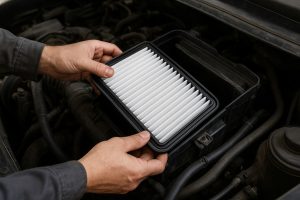When it comes to replacing vehicle filters — be they engine air filters, oil filters, or fuel filters — fitment matters just as much as filtration quality. A filter that is almost right may seem acceptable, but it can lead to unintended consequences for your engine’s performance and longevity. In this article we’ll explore why proper fitment matters, what issues can arise from filters that don’t quite fit, and how you can avoid common mistakes when buying and installing filters. If you’re ready to source replacements, you can also buy Filters online to ensure you get the correct ones.
Why Correct Fitment Is Crucial

When a filter doesn’t fit properly, we’re talking about more than just a sloppy installation or slight inconvenience; several engine-threatening scenarios can play out:
-
Bypass and unfiltered flow: If the filter does not seal correctly (for example the gasket doesn’t sit flush, or the media is bulging), then unfiltered air, oil, or fuel can bypass the filter entirely. An expert noted: “Air filters often fit loosely or lack proper sealing, causing unfiltered air bypass and engine performance issues.”
-
Incorrect size or shape: Aftermarket filters sometimes claim compatibility but may deviate slightly in dimensions, which can lead to improper seating or gaps. One forum user described:
“It fits but has a slight bulge … it’s about 1/16th+ of an inch too big. … The only way to get it in is force the clamps shut on it which I won’t do.”
-
Reduced performance and increased wear: Even a slightly mis-fit filter may restrict airflow or cause higher pressure drop than intended. Over time this degrades engine efficiency and leads to wear. According to an article: “Over time, dirt can clog up the filter, reducing airflow and making the engine work harder – which isn’t great for fuel efficiency or long-term engine health.”
-
Installation errors: Improperly seated filters are surprisingly common. One Reddit user admitted:
“I tried for literally 3 hours once and had 0 luck until I just had it taken apart and installed as a whole.”
Thus, “almost right” is more risky than it may appear.
Key Fitment Issues and Their Consequences
Here’s a breakdown of the most common fitment issues, and what they can lead to:
| Fitment Issue | What “Almost Right” Means | Possible Consequences |
|---|---|---|
| Wrong dimensions (too big / too small) | Filter is slightly oversized/undersized and doesn’t sit flush | Seal gaps, filter movement, unfiltered flow, engine wear |
| Poor gasket seal or missing seal | The gasket may be warped, missing adhesive, or misaligned | Leaks, bypass of contaminants, compromised filtration |
| Incorrect orientation / reversed installation | Filter installed backward or incorrectly placed | Media not in correct flow path, increased pressure drop, reduced life |
| Bulging or deformation of filter media | Aftermarket filter may not match OEM rigid frame or shape | Improper seating, clamps forced shut, higher stress on housing |
| Using wrong part number or generic “close” fit | Filter fits physically but has different internals or less capacity | Filter overload, shorter service life, performance loss |
How to Choose & Install Filters to Avoid “Almost Right” Mistakes
Here is a practical checklist you can follow. Think of it as a step-by-step guide and at-a-glance list of things to verify.
Pre-purchase checklist
-
Verify correct part number: match make / model / year / engine variant.
-
Check dimensions of the filter – especially in applications where tight tolerances matter.
-
Ensure the gasket or seal is in good condition and compatible with your housing.
-
If buying online, consider a vendor with good return policy in case fitment is off (“close” doesn’t count).
-
Avoid generic “fits many” filters if the OEM part is still available — precision matters.
Installation / Fitment steps
-
Remove the housing cover and inspect the filter seat surface — clean any debris or old sealant.
-
Place the new filter and ensure it sits flush and level in the seat.
-
Check the gasket: it should compress properly and form a continuous seal when the cover is closed.
-
Close the housing/clamps slowly and observe if any part of the filter bulges or gets pinched.
-
After installation, run the engine and check for abnormal sounds, leaks or pressure drop if observable.
Follow-up maintenance
-
Monitor the service interval (don’t extend it simply because the filter was “cheap”).
-
Inspect for unusual signs (e.g., reduced performance, increased fuel consumption, check engine light) which may hint at improper fitment or filter overload.
-
Retain installation records (especially in fleet or heavy-duty applications) — proper filter fitment is part of preventive maintenance.
Why It Matters for Your Engine (and Your Wallet)
Here are a few reasons why taking fitment seriously saves you money and heartache:
-
Reduced engine wear: When contaminants pass the filter, they abrade cylinder walls, valves, bearings, etc. Over time this shortens engine life.
-
Better performance & fuel economy: A properly fitted filter ensures correct flow and less restriction, which helps combustion efficiency and power output.
-
Lower risk of service problems: Mis-fit filters can lead to surprising failures (e.g., air filter not seated → check-engine light → diagnostic time and cost) as in user forums.
-
Avoiding “false economy”: A cheap filter that doesn’t fit correctly may cost more in eventual engine damage or repair than the cost saved at purchase.
Quick References

Top-5 “red flags” when installing a new filter
-
Filter shifts or moves in its seat before cover is closed.
-
Gasket doesn’t fully contact the filter housing all around.
-
Cover clamps or bolts require excessive force to close (indicating misalignment).
-
After closing, you notice gaps or bulges in the filter media.
-
The part purchased was labelled “fits many” without specific reference to your make/model.
“Good fitment” summary attributes
-
Exact fit in dimensions and shape.
-
Gasket seals completely around the contact surface.
-
Filter and housing close easily, no pinching or bending.
-
Manufacturer part number or equivalent verified.
-
Post-installation no engine warning, no abnormal noises, normal flow/pressure behaviour.
Final Thoughts
In filter maintenance, the adage holds: “Fit matters.” A filter that is almost correct but doesn’t fit exactly can compromise engine protection, reduce performance, and lead to unexpected repair costs. Whether you’re handling maintenance yourself or overseeing a fleet, it pays to double-check fitment details — dimensions, gaskets, seating — rather than assume “close is good enough.”
When you’re ready to purchase replacement filters, make sure you buy from a reliable source that stocks correct parts and offers good return/fitment support. You can buy Filters online here and look up your engine’s exact filter specification.
By taking fitment seriously now, you’ll save yourself from “almost right” headaches later — and keep your engine running clean, efficient, and trouble-free.